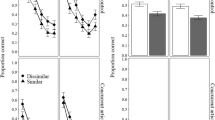Abstract
Different encoding activities during list learning, such as writing down or reading aloud, have a differential effect on memory performance. It has been argued that intermodal processing, that is, auditory processing of visually presented material and vice versa, results in a better performance than intramodal processing. This has been referred to as the “translation hypothesis.” In this study, we set out to test the translation hypothesis looking at all four possible experimental conditions using visual and auditory presentation and writing and vocalization as encoding activities. The results show a similar memory performance in all conditions apart from the one in which visually presented words had to be written down. That is, in the only condition in which subjects did not hear the words (either via auditory presentation or via their own vocalization), fewer words were remembered. These findings do not support the translation hypothesis and are more in agreement with previous theoretical proposals regarding long-term modality effects.
Similar content being viewed by others
References
CAMPBELL, R., & DODD, B, (1980) Hearing by eye. Quarterly Journal of Experimental Psychology, 32A, 85–99.
CONWAY, M. A., & GATHERCOLE, S. E. (1987). Modality and long-term memory. Journal of Memory and Language, 26, 341–361.
CONWAY, M. A., & GATHERCOLE, S. E. (1990). Writing and long-term memory: evidence for a “translation hypothesis”. Quarterly Journal of Experimental Psychology, 42A, 513–527.
ENGLE, R. W., & ROBERTS, J. S. (1982). How long does the modality effect persist? Bulletin of the Psychonomic Society, 19, 343–346.
GARDINER, J. M. (1983). On recency and echoic memory. Philosophical Transactions of the Royal Society of London, B, 302, 267–282.
GARDINER, J. M., & GREGG, V. H. (1979). When auditory memory is not overwritten. Journal of Verbal Learning and Verbal Behavior, 18, 705–719.
GATHERCOLE, S. E., & CONWAY, M. A. (1988). Exploring long-term modality effects: Vocalization leads to better retention. Memory and Cognition, 16, 110–119.
GREENE, R. L., & CROWDER, R. G. (1984). Modality and suffix effects in the absence of auditory stimulation. Journal of Verbal Learning and Verbal Behavior, 23, 371–382.
GREENE, R. L., & CROWDER, R. G. (1986). Recency effects in delayed recall of mouthed stimuli. Memory and Cognition, 14, 355–360.
MURDOCK, B. B., & WALKER, K. D. (1969). Modality effects in free recall. Journal of Verbal Learning and Verbal Behavior, 8, 665–676.
MURRAY, D. J. (1965). The effect of white noise upon the recall of vocalised lists. Canadian Journal of Psychology, 19, 333–345.
NAIRNE, J. S., & WALTERS, V. L. (1983). Silent mouthing procedures modality- and suffix-like effects. Journal of Verbal Learning and Verbal Behavior, 22, 475–483.
PAIVIO, A., & TE LINDE, J. (1982) Imagery, memory and the brain. Canadian Journal of Psychology, 36, 243–272.
PENNEY, C. G. (1989). Modality effects and the structure of short-term verbal memory. Memory and Cognition, 17, 398–422.
SEARLEMAN, A., & HERRMANN, D. (1994). Memory from a broader perspective. New York: McGraw-Hill.
THOMPSON, V. A., & PAIVIO, A. (1994). Memory for pictures and sounds; independence of auditory and visual codes. Canadian Journal of Experimental Psychology, 48, 380–398.
TINDALL-FORD, S., CHANDLER, P., & SWELLER, J. (1997). When two sensory modalities are better than one. Journal of Experimental Psychology: Applied, 3, 257–287.
Author information
Authors and Affiliations
Corresponding author
Rights and permissions
About this article
Cite this article
De Haan, E.H.F., Appels, B., Aleman, A. et al. Inter- and Intramodal Encoding of Auditory and Visual Presentation of Material: Effects on Memory Performance. Psychol Rec 50, 577–586 (2000). https://doi.org/10.1007/BF03395372
Published:
Issue Date:
DOI: https://doi.org/10.1007/BF03395372




